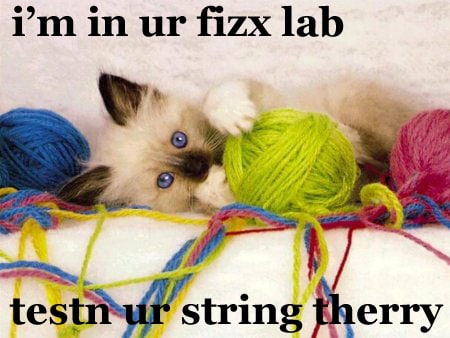
Image from Barbara Jacak’s talk. Credit: icanhazcheezburger.com
By Margaret Harris
Skeptics find much to complain about in string theory, but perhaps their most stinging criticism has been its inability to be falsified by experiment. A few years ago, one string theorist even told me that a particle accelerator big enough to “see” a string would be so large that its opposite ends would be causally disconnected. So this is not a problem we’ll be solving any time soon.
Yet even if we’ll never see a string in the lab, it turns out that string theory does make a few predictions about how matter should behave at the quantum level — and now physicists from the apparently unrelated disciplines of heavy-ion collisions and cold fermions are coming tantalizingly close to testing them.
According to Clifford Johnson of the University of Southern California in Los Angeles, the theory of black holes in 4+1 dimensions (four spatial dimensions plus time) makes a prediction about the ratio of a “perfect” fluid’s viscosity to its entropy. For reasons he didn’t have time to explain in a 15-minute talk, this ratio must be greater than 1/(4 pi).
Now, scientists at Brookhaven National Lab have long been interested in studying the viscosity of the quark-gluon plasmas they create at the Relativisitic Heavy Ion Collider (RHIC). Barbara Jacak of Stony Brook University noted that RHIC data have contained a number of surprises in recent years, including the fact that debris clouds from relativistic gold ion collisions behave more like a liquid than a plasma, with a near-zero viscosity.
Unfortunately, this “quark soup” only exists for tiny fractions of a second after each collision, which makes accurate viscosity measurements extremely difficult. This is where the cold fermions come in. John Thomas of Duke University works on cooling and trapping samples of ^6^Li atoms down to less than one microkelvin above absolute zero. At such temperatures, the Li atoms behave like a near-perfect liquid, too — and they stick around long enough to let Thomas and his group measure their viscosity and entropy.
Thomas told me that they’re still working on refining their measurements, but preliminary data in his talk showed minimum viscosity-to-entropy ratios tailing off at right around the critical value. It’s not quite a confirmation yet, but as Jacak noted, these results are exciting enough to get researchers who “don’t even drink at the same bars, let alone attend the same conferences” talking seriously.
Maybe the orthographically-challenged cat in the photo (which Jacak showed in her talk) is onto something.



